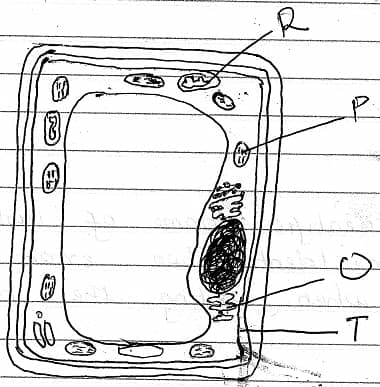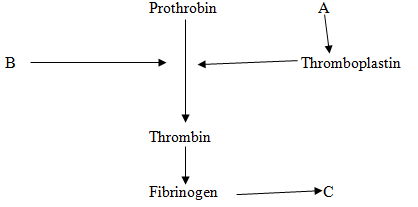INSTRUCTIONS:
- Answer all the questions in the spaces provided.
-
- Name the three main branches of biology. (3mks)
- List two other branches of biology(sub-branches) and for each give a definition. (4mks)
- Biological knowledge can be used to solve environmental problems and enables one to pursue various careers.
- list three environmental problems that can be solved using biological knowledge; (3mks)
- Which three careers require the knowledge of biology. (3mks)
-
- The scientific name of irish potato in Solanum Tuberosum. Identify two errors that have been made when writing the name. (2mks)
- Which taxonomic group does the name solanum refer to? (2mks)
- Which organelles performs the following functions:
- Transports proteins within the cells (1mk)
- Contains lytic enzymes (1mk)
- Processing and transportation of glycoprotein (1mk)
- Regulate the passage of materials into and out of a cell. (1mk)
- The diagram below represents a cell as seen under the electron microscope.

-
- Based on the diagram state whether it represents an animal cell or a plant cell. (1mks)
- Give two reasons for your answer in 5(a)(i) above. (2mks)
- State the functions of the structure labeled P, Q and R. (3mks)
- State three properties of the structure labeled T. (3mks)
- Name the part of the cell that is used in maintaining support in plant cells. (1mk)
-
-
- State the function of the following parts of a light microscope.
- Mirror (1mk)
- Condenser (1mk)
- Eye piece (1mk)
- Which part of a microscope enable one to change from medium to high power objective lens. (1mk)
- Explain why it is not advisable to use the coarse adjustment knob when viewing objects with the high power objective lens. (2 mks)
- State the function of the following parts of a light microscope.
- Study the diagram below and answer the questions below:

- Which physiological process was being investigated? (1mk)
- State two observations made after 30 minute. (2mks)
- Give an explanation for the observation made in 7(b) above. (3mks)
- State two factors that affect the process you named in 7(a) above. (2mks)
-
- Photosynthesis take place in two stages. Name the two stages and state where in the chloroplast each takes place. (4mks)
- State the role of light in the process of photosynthesis. (1mk)
- Which cells in a leaf that contains chloroplasts. (3mks)
- List two raw materials necessary during photosynthesis. (2mks)
-
- Name two enzymes that digest proteins in the human alimentary canal. (2mks)
- Explain why the enzymes you have named in (a) above secreted in inactive form. (1mk)
-
- Name two features that increase the surface area of the small intestines. (2mks)
- During a practical investigation students were provided with the following: Food substance, 10% sodium hydroxide solution, 1% copper sulphate solution and iodine solution.
- Identify two food substances that the students were expected to test. (2mks)
- The diagram below represents a transverse section through a plant organ.
-
- From which plant organ was the section obtained? (2mks)
- Give two reasons for your answer in (a)(i) above (2mks)
- On the diagram identify and name the part that
- Transports water and mineral salts. (1mk)
- Trans - locates synthesized food materials. (1mk)
-
- State two structural differences between arteries and veins. (2mks)
- The diagram below shows a vertical section through a mammalian heart.

- Name the parts labeled A and D. (2mks)
- Use arrows to show the direction in which blood flows out of the heart. (2mks)
- Name the muscle that makes up the heart chambers. (1mk)
- Which part of the heart is referred to as the pacemaker. (1mk)
-
- Give two reasons why blood clotting is important. (2mks)
- The diagram below illustrates the blood clotting process. Use it to answer the questions that follow.
Name- The blood cell represented by A (1mk)
- Metal ion represented by B (1mk)
- End product represented by C (1mk)
-
- State three structures used for gaseous exchange in terrestrial plants. (2mks)
- How are guard cells structurally adapted for gaseous exchange. (4mks)
- Name three structures used for gaseous exchange in frogs. (3mks)
-
- Define respiration. (1mk)
- Name the site of aerobic respiration in a cell. (1mk)
- List two substances needed for respiration to take place. (2mks)
-
- How are the respiratory surfaces in mammals adapted to their functions (3mks)
- State the functions of the following parts of a gill. (3mks)
- Gill rakers
- Gill bar
- Gill filaments

MARKING SCHEME
-
- Botany, zoology, microbiology
-
- Ecology – The study of living organisms in their surroundings
- Entomology – study of insects
- Parasitology – study of parasites
- Ernbryology – study of development of animals from egg to adults
- Physiology - study of body function
- Anatomy – study of internal structures of living organisms
- Cytology – study of cells
- Pathology – study of fishes
- Bacteriology – study of Bacteria
- Morphology – study of external structure of organisms
- Biochemistry – study of chemistry of materials
- Taxnoomy – study of classification – sorting out of organisms into groups
- Histology – study of tissues
- Virology – study of viruses
(any two)
-
- Food shortage, pollution, drought, poor health, conservation of natural resource
- Medicine, dentistry, agriculture, public health, veterinary practice, horticulture, nursing etc
-
-
- The species name starts with a capital letter.
- The names are not underlined separately or italicized.
- Genus
-
-
- rough endoplasmic reticulum
- Lysosomes
- Golgi apparatus
- Cell membrane
-
-
- plant cell
-
- presence of a cell wall
- Presence of a chloroplast
- Is regular in shape
-
- P - chloroplast – site of photosynthesis
- Q - smooth endoplasmic reticulum – manufacture and transport lipid
- R - Mitochondrion – site of respiration
- T
- Cell membrane
- Sensitive to change in temperature and pH
- has electrical change positive and negative charges
- it is semi-permeable
- Cell wall
-
-
-
- Mirror – reflects and directs light to the specimen
- Condenser – concentrates and directs light to the specimen on the stage
- Eye piece – magnifies the image of the object
-
- It may crush and destroy the objective lens
- it may damage the slide containing the specimen
-
-
- Diffusion
-
- The starch solution inside the visking change from white to blue-black colour
- The iodine solution in the beaker across the visking tubing by diffusion where they caused the starch solution to change to blue black.
- Starch molecules are large sized and cannot pass through the small pores of the visking tubing. Therefore the iodine solution did not change.
-
- Surface area:
- surface area to volume ratio
- temperature
- size of the molecules.
- Thickness of the wall, tissue or member
-
-
- Stage I – Light stage – occurs in the granum
- Stage II - dark stage – occurs in the stroma.
-
- Light provides energy required for splitting water molecules into hydrogen atoms and oxygen gas, a process called photolysis
- Light is used in synthesis of energy in the form of adenosine triphosphate(ATP)
-
- Spongy mesaphyll cells
- palisade mesaphyll cell
- guard cells
-
- carbon(IV) oxide
- water
-
-
-
- pepsin
- Trypsin
- so that they do not digest the cells that secrete them
-
-
-
- long and coiled in length
- Presence of many villi and microvilli
-
- protein
- starch
-
-
-
- dicotyledonous sten
-
- lacks root hairs
- Vascular bundles are arranged in a ring around a central pith
-
- xylem
- phloem
-
Arteries Veins Have thick muscular walls Have thin less muscular walls Have no valves(except at the base of pulmonary artery and aorta) Have valves at regular intervals Have a narrow lumen Have a wide lumen Have elastic walls Have less elastic walls - A - AORTA
D – right atrium/auricle - Cardiac muscle
- Sino atrial Node(SAN)
- A - AORTA
-
-
- to prevent excessive loss of blood when injured
- The clot prevents entry of pathogen into the injured tissues
-
- Platelets
- Calcium ions
- Fibrin/clot
-
-
-
- Stomata in the leaves
- Lenticels on the woody stems
- Epidermal cells on the roots/cubicle
-
- guard cells has thicker inner wall and thin outer wall to allow for differential expansion
- contains chloroplasts unlike other adjacent epidermal cells for photosynthesis when glucose formed alters the osmotic pressure of guard cells.
- they are bean shaped and face one another to form an aperture/pore.
-
- skin
- buccal cavity
- lungs
-
-
- it is the process by which food substances are broken down in the cell to release energy
- Mitochondrion\
-
- Food substance/glucose
- Oxygen
-
-
- Highly vascuralised /rich network of capillaries to maintain a steep concentration gradient.
- Moist to dissolve gases
- Thin epithelial lining that is thin to provide a short distance for diffusing gases to cover.
- Numerous to offer a large SA for maximum gaseous exchange.
-
- Gill rakers - Trap/filters solid particles present in water/prevent solid particles from reaching the delicate gill filament so as to protect them from mechanical damage.
- Gill bar – Provide a surface for attachment of gill rakers and gill filaments
- Gill filaments- Provide a large surface area for gaseous exchange.
-
Join our whatsapp group for latest updates
Tap Here to Download for 50/-
Get on WhatsApp for 50/-
Download Biology Questions and Answers - Form 2 Term 3 Opener Exams 2022.
Tap Here to Download for 50/-
Get on WhatsApp for 50/-
Why download?
- ✔ To read offline at any time.
- ✔ To Print at your convenience
- ✔ Share Easily with Friends / Students



